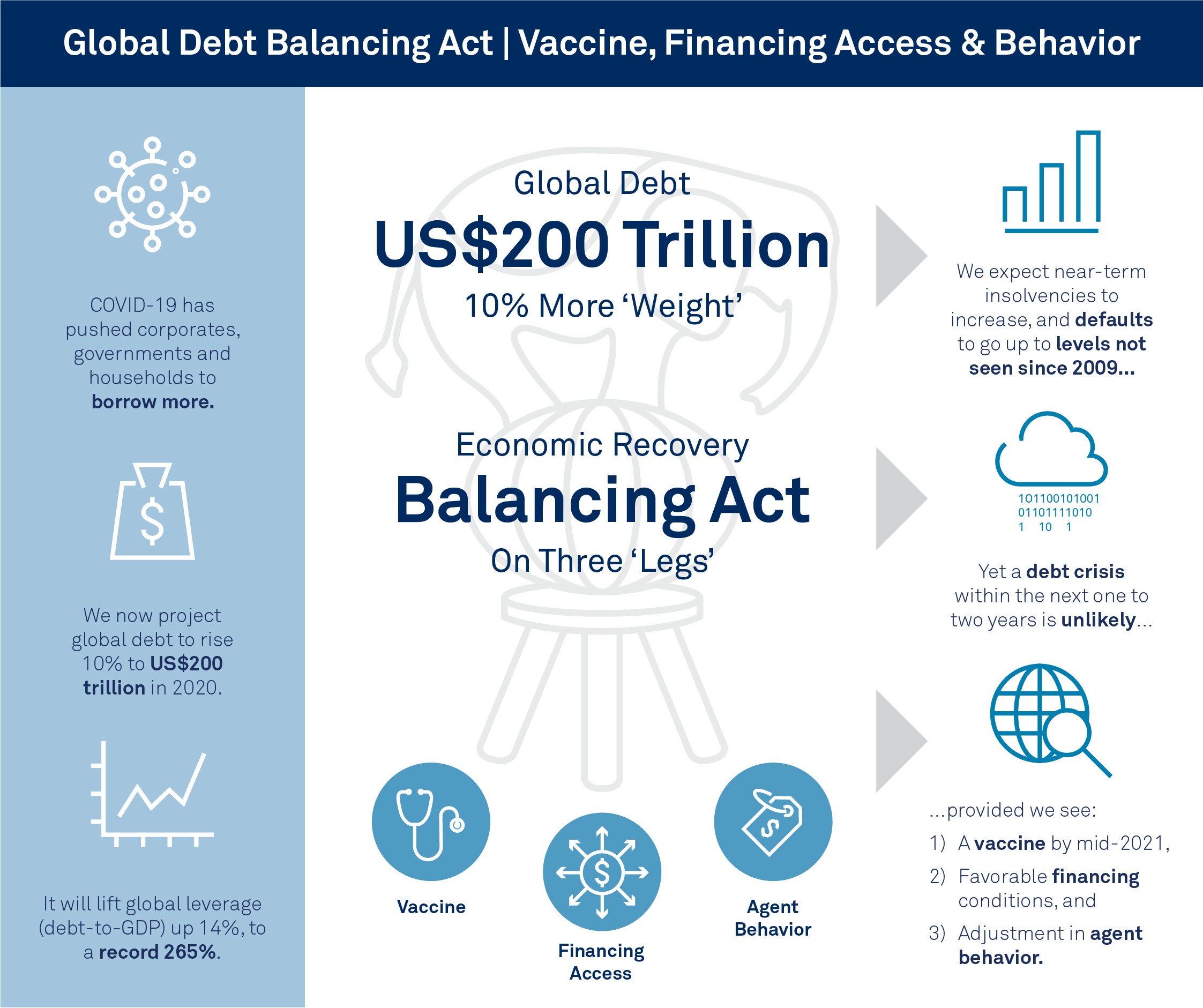Authors: Terence Chan, CFA, David Tesher, Alexandra Dimitrijevic, Paul Gruenwald, Jose Perez-Gorozpe, Paul Watters, CFA, Gareth Williams, Michelle Hsiung, Joe Maguire, Yucheng Zheng
Published Oct. 27, 2020
We believe a near-term debt crisis is unlikely. Although we project global debt-to-GDP in 2020 to jump 14% to a record 265%, a debt crisis within the next two years is not likely given the expected economic recovery, a vaccine by mid-2021, favorable financing conditions, and sovereign, corporate and household spending and borrowing behaviors.
Risks remain on the downside. These include the economic recovery stumbling, a continued spread of the pandemic or poor vaccine distribution, a sustained surge in interest rates and dramatic widening of credit spreads, no notable deceleration of growth in debt after this year, and consumption demand rebounding less than we expect.
We expect global debt-to-GDP to surge 14% to 265% by year end before easing off as the world slowly recovers toward pre-coronavirus income levels. Higher leverage, together with a more challenging operating environment, has led us to downgrade 22% of corporate and sovereign issuers globally—particularly speculative-grade borrowers and those suffering most from COVID19’s economic effects.
Insolvency risk will likely increase for some corporate borrowers if cash flows and earnings don’t return to pre-pandemic trends before the withdrawal of extraordinary fiscal and monetary stimulus. Indeed, default rates could double by mid-2021. Leverage growth may level off in the coming years as corporates rethink revenue and investment opportunities, governments rebuild balance sheets, and households turn more conservative.
However, we believe a near-term debt crisis is unlikely. This is based on our base-case assumption of a continuing, albeit choppy, global economic recovery. The recovery, in turn, is predicated on the wide availability of a COVID-19 vaccine by mid-2021, continuing accommodative financing conditions, and adjustments in corporate, government, and household spending and borrowing behaviors (see chart 1). Given the commitments of governments and pharmaceutical manufacturers, we assume a coronavirus vaccine will be widely available next year.
Unprecedented fiscal stimulus from governments around the globe, combined with equally massive central bank monetary stimulus, has helped keep the liquidity tap open for corporates through the bond markets and bank loans. We expect benchmark interest rates to remain low into 2023. In the U.S., the Federal Reserve has said it may allow inflation to run higher than its previous target of 2% while keeping the federal funds rate low to spur job growth. Meanwhile, credit spreads have tightened from the highs in March and are, for now, more sensitive to business-specific risks than market risks—albeit with residual sensitivity for the lowest-quality borrowers.
A substantial portion of global debt is funded by banks. We expect most major banks should be able to absorb credit losses arising these two years, given core earnings. Banks should largely be able to continue lending, moving back to business as usual by 2023. Regulators’ responses to the economic shock have bolstered banks’ ability and willingness to lend and support customers. The withdrawal of fiscal measures could reveal new fragilities in asset quality, and borrower forbearance may mask declining asset quality. For banks globally, we forecast credit losses of about $2.1 trillion for 2020-2021, with this year’s $1.3 trillion more than double the 2019 level.

The higher household debt-to-GDP ratio in 2020 is driven in part by the decline in GDP. Households often initially take on more debt as they cope with income loss. Observing their behavior in past downturns, we expect households to turn conservative thereafter and slow down debt growth. After some incremental improvements in 2021, we expect global household debt-toGDP to end 2023 at 66%, the same as our projection for end-2020.
There are significant risks to our base case. These include economic shocks slowing the return to pre-pandemic income levels, accelerated infection rates or poor vaccine distribution, rising interest rates and a sustained dramatic widening of credit spreads, continuing debt growth, and consumption demand rebounding less than we expect as a result of structural shifts.
The short-term outlook remains stressful, particularly for borrowers at the lower end of the credit scale or in industries most exposed to social distancing measures and the economic downturn. Indeed, our baseline is for the 12-month trailing speculative-grade corporate default rate to double in the U.S. to 12.5% by June 2021 (from a preliminary 6.3% in September 2020) and to 8.5% in Europe (from 4.3%). Globally, the 12-month trailing speculative-grade corporate default rate hit 4.9% in September 2020.
Here, it’s worth noting that looking only at the absolute level of debt offers an incomplete view— especially given that borrowing costs are very low, and appear likely to remain so, for a protracted period. Whether a debt load is too heavy depends as much on a borrower’s ability to pay off that debt as it does on its absolute amount. It’s also important to recognize the feedback loop involved, given that the debt surge is helping to drive the very same economic recovery that is crucial to borrowers’ ability to pay off debt. This is especially true for sovereigns, whose fiscal stimulus measures (while adding significantly to their debt burdens) have helped make the economic downturns in their countries or regions far shallower than they might otherwise have been.